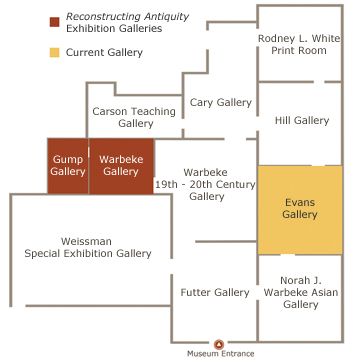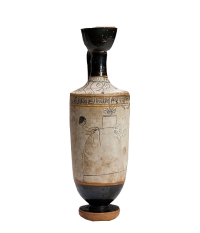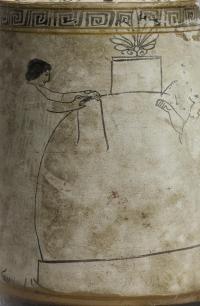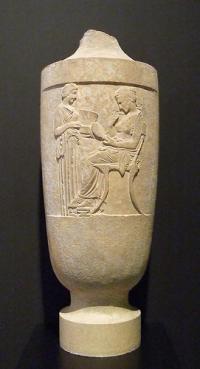Two women at a tomb
Learn more about the object below
Before it was fired, the reddish clay of this lekythos (oil vessel) was painted in a purified slip, which the heat of the kiln turned a ghostly white. Popularized in the 5th century BCE, this “white ground” technique was generally only used for funerary vessels such as this, because the white slip was too delicate for the daily handling encountered by domestic items. The white background also meant the vessels could be decorated more colorfully: in addition to red and black paint, blue, green and ochre were sometimes used. These vivid, emotionally accessible scenes make their usual subject matter—death and loss—all the more poignant.
Archaeologists often discover lekythoi like this one near ancient Athenian graves, suggesting their original function. Lekythoi were generally painted with scenes of death and burial; giant versions were sometimes even used as grave markers. But how did the lekythos, a vessel for storing and pouring olive oil, become so closely associated with death? The grieving family ritually anointed the corpse to be buried with oil from lekythoi. Many also left lekythoi as ritual grave offerings, brimming with oil for the deceased. Because olive oil was so expensive a commodity, shrewd relatives commissioned special shallow lekythoi, which appeared to overflow with oil, when actually they held only a few ounces!
To die in ancient Athens was to pass into the hands of the women of the household. Women washed the corpse, anointed it, and readied it for burial. During the prosthesis (lying-in-state) women stood close around the bier in lamentation. They accompanied the body in procession to a cemetery outside the city boundaries with cries of “Oimoi!” (alas), ritually striking their faces and chests, and tearing their hair in grief. On certain days each year, family members, typically women, returned to the grave with small offerings, including ribbons, fillets or garlands to decorate the tomb.
Label text by August Thomas, Museum Volunteer.
Suggested readings:
Jenifer Neils and John H. Oakley, Coming of age in ancient Greece : images of childhood from the classical past. New Haven: Yale University Press in association with the Hood Museum of Art, Dartmouth College, Hanover, New Hampshire, 2003.





